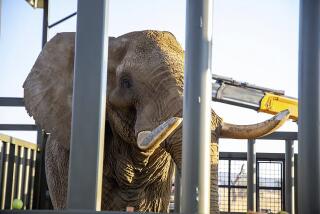Some See Red Over Pachyderm Paint Plan : Africa: Zimbabwe safari operator sees profit in taking tourists to hunt elephants with dye guns. Opponents say big beasts may not stand still for polka dots.
MATETSI SAFARI AREA, Zimbabwe — Rifle at the ready, Adrian Read stalked slowly through the tall grass and thorn bushes. Suddenly he stopped and patted the air with his hand.
The signal was clear: Quiet--elephants ahead.
Moving quickly through the brush to stay downwind of the seven huge cows and calves, the 32-year-old professional hunter quickly raised the gun to his shoulder and fired. Splat! The shot hit the closest elephant’s ear.
Then twice more, once to the trunk and then a would-be kill shot smack on the giant gray forehead. Splat! Splat! With that, the polka-dotted pachyderm turned and ran with the herd.
Welcome to splatball safaris, the latest and strangest attempt to marry two of humankind’s most primal urges: to hunt large animals and to separate tourists from their wallets.
Here in a corner of a million-acre tract filled with some of Africa’s most dangerous game, Read plans to begin leading safaris this November for anyone willing to pay $700 a day to shoot bull elephants, Cape buffalo or other wild animals with marble-sized gelatin pellets filled with nontoxic, neon-orange vegetable dye. The only trophy would be a video--for another $150 or so.
“We call it eco-hunting,” said Read’s partner, Dave Rhodes. “It’s for people who want to hunt but don’t want to kill. Some people say it’s a contradiction in terms.”
Actually, some say much worse. Mike Kock, chief veterinarian with the Zimbabwe department of national parks and wildlife management, calls the scheme “bizarre.”
“They’d better have good medical insurance,” he said. “The risk to the person doing it would be my concern. You’ll probably just piss a lot of animals off.”
Dick Pitman, head of the nonprofit conservationist Zambezi Society, is also dubious. “What for?” was his initial reaction. “How many animals are they going to have to shoot (with a real gun) when the animal turns and charges?”
“I don’t think it’s ethically right,” said Jules Turnbull-Kemp, managing director of Kgama Wildlife Operations in South Africa, which sells safaris for hunters to shoot tranquilizer darts at rhinos before they are moved, and cull excess elephants and other large game in national parks. “Why not just sneak up and shoot it with a camera?”
Read, a tall, taciturn man who also runs regular hunting safaris, concedes that not every elephant will be so cooperative as to simply run away, as the three he splatted for demonstration purposes did on a recent sunny afternoon.
He said he will charge full safari prices to cover the government trophy fees if he has to kill an angry tusker with the .458 Winchester elephant gun that an aide carries close by. “And eventually we’ll have to,” he said.
But that is one of the selling points, Rhodes said.
“The thing about this is it’s even more dangerous than normal hunting,” he said. “Because once shot, the animal’s not dead. He can still come at you.”
Both men insist that the elephants are not harmed by the pellet, and that the dye quickly fades. To demonstrate, Read shot his partner in the back from about 10 feet away. It left a nasty purple bruise on his back and a large orange splotch on his shirt that did not fade after four hours.
At nearby Victoria Falls, thrill-seekers line up to pay $90 to bungee jump off a bridge that spans the stunning 340-foot-deep Zambezi River gorge. It is advertised as the highest commercial bungee jump in the world, as well as “the most awesome and terrifying experience of your life.”
Others fly sputtering light aircraft over the thundering falls, or are flung from rafts as they white-water down the raging Zambezi. Those unwilling to risk their lives in such adventure sports need only visit the park that flanks the famous falls.
In a part of the planet that apparently never heard of liability insurance, tourists may literally walk up to the edge of the chasm, where, at most, a small barrier of thorn bushes blocks the way.
And big game hunting is still hugely popular here. The truly rich aim for the endangered rhinoceros in South Africa, where about 70 of the older animals are killed each year for fees ranging up to $50,000.
Turnbull-Kemp says many of his clients take home not just the head as a trophy, but the entire animal. For the record, a taxidermist charges $25,000 to stuff and mount a rhino.
“We had one chap a few years ago who took two, one for him and one for his wife,” he said. “They had to take the roof off their house to lower them in with a crane.”
Still, shooting orange dye at two-ton animals with tusks--not to mention more aggressive Cape buffalo, usually considered the most dangerous animal to hunt--seems like a sport apart.
Read got the idea last year when he borrowed a splat gun from Rhodes, who had failed in an attempt to run paintball war games for weekend warriors. Read wanted to use the Uzi-sized gun, which is powered by a CO2 cartridge, to help train aspiring game rangers. He soon began splatting elephants instead.
And elephants abound here, as do lions, zebra, giraffes, impala and scores of other species. They make their home amid the expanse of teak and bloodwood trees that dot the rocky ridges and sandy soil.
Both men say they are sensitive to charges that splatballing is, as one colleague recently complained to them, “degrading for the elephant.”
“I said it was far more degrading to get a .458 bullet through the brain than a splat on the forehead,” Rhodes said.
More to Read
Sign up for Essential California
The most important California stories and recommendations in your inbox every morning.
You may occasionally receive promotional content from the Los Angeles Times.











